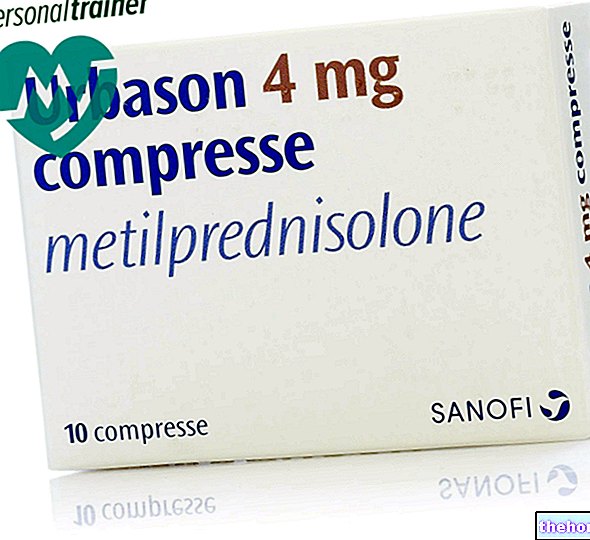Active ingredients: Fusidic acid, Hydrocortisone (Hydrocortisone acetate)
FUCIDIN H 20 mg / g + 10 mg / g cream
Why is Fucidin H used? What is it for?
Fucidin H cream combines the antibacterial activity of fusidic acid (antibiotic) with the anti-inflammatory effect of hydrocortisone acetate (corticosteroid).
It is used for the topical treatment of infected atopic dermatitis (commonly known as eczema, a skin disease accompanied by inflammation, redness, exudation or scabs and itching, often of allergic origin).
Talk to your doctor if you don't feel better or if you feel worse.
Contraindications When Fucidin H should not be used
Do not use Fucidin H:
- if you are allergic to fusidic acid, sodium fusidate, hydrocortisone acetate or any of the other ingredients of this medicine (listed in section 6).
- if you have a "skin infection mainly caused by bacteria, fungi or viruses (such as herpes or chickenpox)
- if you have tuberculosis
- if you have dermatitis around the mouth
- if you have rosacea (severe redness of the skin on the face).
Precautions for use What you need to know before taking Fucidin H.
- Talk to your doctor or pharmacist before using Fucidin H.
- Fucidin H should be applied carefully to areas close to the eyes. Fucidin H must not enter the eyes.
- The use of Fucidin H is limited to 2 weeks. Prolonged treatments may increase the risk of side effects and the risk of antibiotic resistance, for example your skin may become thin.
- Fucidin H can mask symptoms of a potential infection
- Fucidin H can increase its susceptibility to infections, aggravate existing infections, and activate latent infections.
Children and adolescents
Fucidin H should be used with caution in children.
Interactions Which drugs or foods can modify the effect of Fucidin H
H Tell your doctor or pharmacist if you are taking or have recently taken or might take any other medicines.
Warnings It is important to know that:
Pregnancy and breastfeeding
If you are pregnant or breast-feeding, think you may be pregnant or are planning to have a baby, ask your doctor or pharmacist for advice before taking this medicine.
Use during pregnancy and lactation should be evaluated and established by a physician.
Fucidin H should be used with caution during pregnancy.
Fucidin H can be used during breastfeeding but it is recommended to avoid using it on the breast.
Effects on ability to drive and use machines
Treatment with Fucidin H cream does not affect driving and use of machines.
Fucidin H contains butyl hydroxyanisole (E320), cetyl alcohol and potassium sorbate (E202)
These components can cause local skin reactions (eg contact dermatitis). Butyl hydroxyanisole can also cause irritation of the eyes and mucous membranes (such as the nasal passages and lips).
Dose, Method and Time of Administration How to use Fucidin H: Posology
Always use this medicine exactly as your doctor has told you. If in doubt, consult your doctor or pharmacist.
The recommended dose for children, adolescents and adults is: Carefully apply a thin layer of the cream to the diseased area of the skin, three times a day. Fucidin H should not be used for more than 2 weeks.
Wash your hands thoroughly after each application, unless your hands are the area to be treated.
Overdose What to do if you have taken too much Fucidin H.
If you use more Fucidin H than you should
If you have used more cream than you should, consult your doctor or pharmacist.
If you forget to use Fucidin H.
If you forget to apply the cream at the scheduled time, apply it as soon as possible and then continue the treatment as usual.
If you stop taking Fucidin H.
If you forget to use this medicine, use it as soon as you remember. Then use the medicine at the usual time.
If you have any further questions on the use of Fucidin H, ask your doctor or pharmacist.
Side Effects What are the side effects of Fucidin H.
Like all medicines, Fucidin H can cause side effects, although not everybody gets them.
Common side effects (affects 1 to 10 users in 100)
- application site reaction (e.g. skin irritation, skin burning or itching)
Uncommon side effects (affects 1 to 10 users in 1000)
- hypersensitivity contact dermatitis worsening of eczema rash
Other side effects caused by prolonged treatment with mild corticosteroids such as hydrocortisone included:
- thinning of the skin (skin atrophy)
- dermatitis
- stretch marks (striae)
- dilation of small vessels on the skin
- persistent redness of the face (rosacea)
- redness of the skin (erythema)
- depigmentation
- excessive hair growth (hypertrichosis)
- excessive sweating (hyperhidrosis)
- bruises
- systemic side effects caused by mild corticosteroids such as hydrocortisone, include adrenal suppression especially during prolonged topical administration
- complications if given too close to the eyes (e.g. increased intra-ocular pressure and glaucoma).
If you get any side effects, talk to your doctor or pharmacist. This includes any possible side effects not listed in this leaflet.
Expiry and Retention
Keep this medicine out of the sight and reach of children.
Do not use this medicine after the expiry date which is stated on the carton after EXP. The expiry date refers to the last day of the month.
This medicine does not require any special storage conditions.
Do not throw any medicines via wastewater or household waste. Ask your pharmacist how to throw away medicines you no longer use. This will help protect the environment.
Composition and pharmaceutical form
What Fucidin H
- The active ingredients are fusidic acid and hydrocortisone acetate. Each gram of cream contains 20 mg of fusidic acid and 10 mg of hydrocortisone acetate.
- The other ingredients are butylated hydroxyanisole (E320), cetyl alcohol, glycerol (85%), liquid paraffin, potassium sorbate (E202), polysorbate 60, white petroleum jelly, all-rac-α-tocopherol, hydrochloric acid and purified water.
Description of what Fucidin H looks like and contents of the pack
Fucidin H is a white cream.
Each pack contains a tube with 5, 15 or 30 g of cream.
Not all pack sizes may be marketed.
Source Package Leaflet: AIFA (Italian Medicines Agency). Content published in January 2016. The information present may not be up-to-date.
To have access to the most up-to-date version, it is advisable to access the AIFA (Italian Medicines Agency) website. Disclaimer and useful information.
01.0 NAME OF THE MEDICINAL PRODUCT
FUCIDIN H, 20 MG / G + 10 MG / G CREAM
02.0 QUALITATIVE AND QUANTITATIVE COMPOSITION
Fusidic acid 20 mg / g and hydrocortisone acetate 10 mg / g.
Excipients with known effects:
Butyl hydroxyanisole E320 (40 mcg / g), cetyl alcohol (111 mg / g) and potassium sorbate E202 (2.7 mg / g).
For the full list of excipients, see section 6.1.
03.0 PHARMACEUTICAL FORM
Cream.
White cream miscible in water.
04.0 CLINICAL INFORMATION
04.1 Therapeutic indications
Treatment of infected atopic dermatitis.
04.2 Posology and method of administration
Adults and pediatric population:
Fucidin H cream should be applied to affected skin areas 3 times a day, for up to 2 weeks.
04.3 Contraindications
Hypersensitivity to the active substances or to any of the excipients listed in section 6.1.
Due to the corticosteroid contained, Fucidin H is contraindicated in the following conditions:
Primary skin infections caused by bacteria, fungi or viruses, either untreated or not controlled with appropriate therapy (see section 4.4).
Skin manifestations related to tuberculous processes either untreated or not controlled by adequate therapy. Perioral or rosacea dermatitis.
04.4 Special warnings and appropriate precautions for use
Long-term continuous topical therapy with Fucidin H should be avoided.
Depending on the site of application, the possible occurrence of systemic absorption of hydrocortisone acetate should always be kept in mind during treatment with Fucidin H.
Fucidin H should be used with caution in areas close to the eyes, due to the corticosteroid it contains. Avoid getting Fucidin H in the eyes (see section 4.8).
Reversible suppression of the hypothalamic-pituitary-adrenal (HPA) axis may occur following systemic absorption of topical corticosteroids.
Fucidin H should be used with caution in children who as pediatric patients may be more susceptible to topical corticosteroid-induced HPA axis suppression and Cushing's syndrome than adult patients (see section 4.8).
Cases of bacterial resistance have been reported associated with the use of topical fusidic acid. As with all antibiotics, prolonged or recurrent use of fusidic acid may increase the risk of developing antibiotic resistance. Limiting fusidic acid and topical hydrocortisone acetate therapy to no more than 14 days reduces the risk of developing resistance.
This will also reduce the risk that the immunosuppressive action of the corticosteroid can mask the symptoms of a potential infection caused by antibiotic-resistant bacteria.
Fucidin H may be associated with increased sensitivity to infections, the aggravation of an existing infection and the activation of a latent infection due to the immunosuppressive action of corticosteroids. Switching to systemic treatment is recommended if infection cannot be controlled with topical treatment (see section 4.3).
Fucidin H cream contains butyl hydroxyanisole, cetyl alcohol and potassium sorbate. These excipients can cause local skin reactions (e.g. contact dermatitis).
Butyl hydroxyanisole can also cause irritation of the eyes and mucous membranes.
Atrophic changes may occur on the face and to a lesser extent in other parts of the body after prolonged treatment with topical corticosteroids.
04.5 Interactions with other medicinal products and other forms of interaction
No interaction studies have been performed. Interactions with systemically administered medicinal products are considered to be minimal
04.6 Pregnancy and lactation
Pregnancy
Fusidic acid:
No effects are expected during pregnancy as systemic exposure to fusidic acid is negligible.
Hydrocortisone acetate:
A large amount of data on pregnant women (more than 1000 pregnancy outcomes) indicate neither malformations nor fetal / neonatal toxicity due to corticosteroids.
There are insufficient clinical data on the treatment of pregnant women with Fucidin H. If clinically necessary, Fucidin H should be used with caution during pregnancy.
Feeding time
No effects on the breastfed newborn / infant are expected as systemic exposure following the application of fusidic acid and hydrocortisone acetate to a limited area of the breastfeeding woman's skin is negligible.
Fucidin H can be used during breastfeeding, but it is recommended to avoid applying Fucidin H to the breast.
Fertility
There are no clinical studies with Fucidin H regarding fertility.
04.7 Effects on ability to drive and use machines
Fucidin H cream has no or negligible influence on the ability to drive or use machines.
04.8 Undesirable effects
The estimate of the frequency of adverse reactions is based on a "pooled analysis of data from clinical trials and spontaneous reports."
The most frequently reported adverse reactions during treatment are application site reactions including itching, burning and irritation.
Adverse reactions are classified using MedDRA System Organ Class (SOC) and individual adverse reactions are listed starting with the most frequently reported. Within each frequency grouping, adverse reactions are presented in order of decreasing severity.
Very common ≥ 1/10
Common ≥ 1/100,
Uncommon ≥ 1 / 1,000,
Rare ≥ 1 / 10,000,
Very rare
Systemic undesirable effects related to the corticosteroid class such as hydrocortisone include adrenal suppression especially during prolonged topical administration (see section 4.4).
Increased intraocular pressure and glaucoma may also occur after topical use of corticosteroids near the eyes, especially with prolonged use and in patients predisposed to developing glaucoma (see section 4.4).
Dermatological side effects related to the mild corticosteroid class such as hydrocortisone include: atrophy, dermatitis (including contact dermatitis, acneiform dermatitis and perioral dermatitis), skin striae, telangiectasias, rosacea, erythema, depigmentation, hypertrichosis and hyperhidrosis. Ecchymosis may also occur. with prolonged use of topical corticosteroids.
Class effects related to corticosteroids have been reported uncommonly for Fucidin H as described in the frequency table above.
Pediatric population
The observed safety profile is similar in children and adults (see section 4.4).
04.9 Overdose
For topically applied fusidic acid, no information is available regarding potential symptoms and signs of overdose. Cushing's syndrome and adrenal insufficiency may develop following topical application of large amounts of corticosteroids for more than three weeks.
Systemic consequences of an overdose of the active substances are unlikely to occur after accidental oral intake. The amount of fusidic acid in a tube of Fucidin H does not exceed the daily oral dose of systemic treatment. A single oral overdose of corticosteroids is rarely a clinical problem.
05.0 PHARMACOLOGICAL PROPERTIES
05.1 Pharmacodynamic properties
Pharmacotherapeutic group: Hydrocortisone and antibiotics, ATC code: D07CA01
Fucidin H cream combines the antibacterial activity of fusidic acid with the anti-inflammatory effect of hydrocortisone acetate.
05.2 Pharmacokinetic properties
Education in vitro have shown that fusidic acid can penetrate intact skin. The degree of penetration depends, in part, on exposure and in part on the condition of the skin.
Fusidic acid is mainly excreted in the bile and only to a small extent in the urine.
Hydrocortisone acetate is absorbed after topical application. The extent of absorption depends partly on the condition of the skin and partly on the site of application. The absorbed hydrocortisone is rapidly metabolized and excreted in the urine.
05.3 Preclinical safety data
Apart from what is described in the other sections of the SPC, no other preclinical data relevant to the prescriber is available.
06.0 PHARMACEUTICAL INFORMATION
06.1 Excipients
Butyl hydroxyanisole (E320), cetyl alcohol, glycerol (85%), liquid paraffin, potassium sorbate (E202), polysorbate 60, white petroleum jelly, all-rac-α-tocopherol, hydrochloric acid and purified water.
06.2 Incompatibility
Not known.
06.3 Period of validity
3 years.
Validity after first opening: 3 months.
06.4 Special precautions for storage
Do not store above 30 ° C.
06.5 Nature of the immediate packaging and contents of the package
Aluminum tube with polyethylene screw cap.
Packaging: 5 g, 15 g and 30 g.
Not all pack sizes may be marketed.
06.6 Instructions for use and handling
No special instructions.
Unused medicine and wastes derived from this medicine must be disposed of in accordance with local regulations.
07.0 MARKETING AUTHORIZATION HOLDER
LEO PharmaA / S
Industriparken 55
DK-2750 Ballerup
Denmark
Dealer for Italy: LEO Pharma S.p.A. Via Amsterdam 125 00144 Rome.
08.0 MARKETING AUTHORIZATION NUMBER
5 g tube - A.I.C. n. 034560033
15 g tube - A.I.C. n. 034560019
Tube 30 g - A.I.C. n. 034560021
09.0 DATE OF FIRST AUTHORIZATION OR RENEWAL OF THE AUTHORIZATION
Date of first authorization: 4 February 2000
Date of last renewal: June 4, 2007
10.0 DATE OF REVISION OF THE TEXT
4 September 2014




























